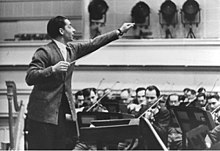
Back Dirigieren ALS قيادة موسيقية Arabic সঙ্গীত সঞ্চালনা Bengali/Bangla ڕێبەریکردن (مۆسیقا) CKB Arweinydd (cerddoriaeth) Welsh Dirigieren German Διεύθυνση ορχήστρας Greek Dirigentado Esperanto Dirección de orquesta Spanish Orkestra zuzendaritza Basque

Conducting is the art of directing a musical performance, such as an orchestral or choral concert. It has been defined as "the art of directing the simultaneous performance of several players or singers by the use of gesture."[1] The primary duties of the conductor are to interpret the score in a way that reflects the specific indications in that score, set the tempo, ensure correct entries by ensemble members, and "shape" the phrasing where appropriate.[2] Conductors communicate with their musicians primarily through hand gestures, usually with the aid of a baton, and may use other gestures or signals such as facial expression and eye contact.[3] A conductor usually supplements their direction with verbal instructions to their musicians in rehearsal.[3]
The conductor typically stands on a raised podium with a large music stand for the full score, which contains the musical notation for all the instruments or voices. Since the mid-19th century, most conductors have not played an instrument when conducting, although in earlier periods of classical music history, leading an ensemble while playing an instrument was common. In Baroque music, the group would typically be led by the harpsichordist or first violinist (concertmaster), an approach that in modern times has been revived by several music directors for music from this period. Conducting while playing a piano or synthesizer may also be done with musical theatre pit orchestras. Instrumentalists may perform challenging works while conducting - for instance, it is not uncommon to see a pianist perform a concerto while also conducting the orchestra. Communication is typically non-verbal during a performance. However, in rehearsals, frequent interruptions allow the conductor to give verbal directions as to how music should be performed.
Conductors act as guides to the orchestras or choirs they conduct. They choose the works to be performed and study their scores, to which they may make certain adjustments (such as in tempo, articulation, phrasing, repetitions of sections), work out their interpretation, and relay their vision to the performers. They may also attend to organizational matters, such as scheduling rehearsals,[4] planning a concert season, hearing auditions and selecting members, and promoting their ensemble in the media. Orchestras, choirs, concert bands, and other sizable musical ensembles, such as big bands are usually led by conductors.
- ^ Sir George Grove, John Alexander Fuller Maitland, eds. (1922). A Dictionary of Music and Musicians, Volume 1, p. 581. Macmillan.
- ^ Kennedy, Michael; Bourne Kennedy, Joyce (2007). "Conducting". Oxford Concise Dictionary of Music (Fifth ed.). Oxford University Press, Oxford. ISBN 9780199203833.
- ^ a b Holden, Raymond (2003). "The technique of conducting". In Bowen, José Antonio (ed.). The Cambridge Companion to Conducting. Cambridge: Cambridge University Press. p. 3. ISBN 0-521-52791-0.
- ^ Espie Estrella (6 March 2017). "The Conductor". thoughtco.com. Retrieved 9 March 2018.